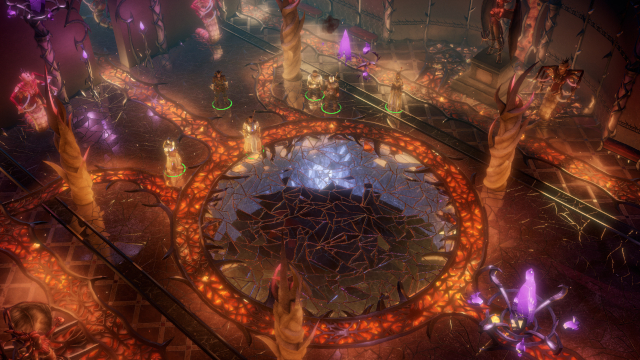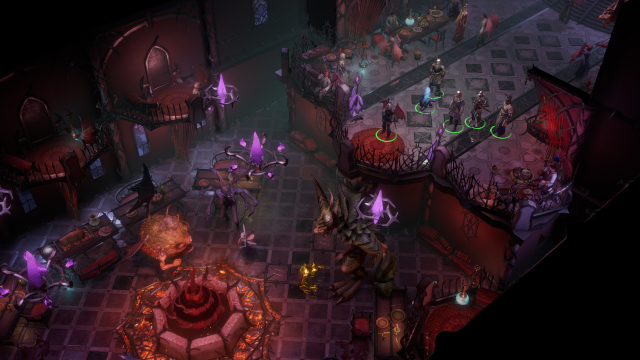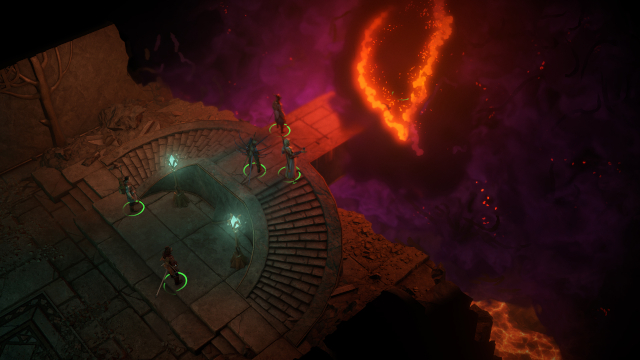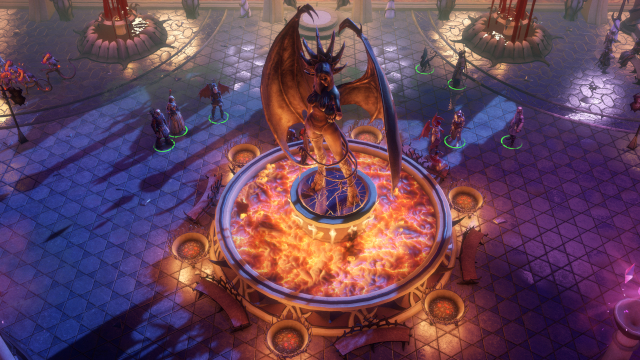If you’re getting tired of waiting for Baldur’s Gate 3 to exit Early Access, and if you’re jonesing for another D&D-themed top-down roleplaying game, you may want to check out Pathfinder: Wrath of the Righteous when it releases this September. Wrath of the Righteous is the latest game to carry the CRPG genre torch, indirectly following up 2018’s Pathfinder: Kingmaker.
This past week, I got a chance to drop into the official Pathfinder: Wrath of the Righteous beta and get a feel for how it plays, including story structure and combat.
Granted, I don’t have a foundational understanding of the Pathfinder series, having never played a game in the series. My closest point of reference is the Pillars of Eternity series, Divinity: Original Sin 2, and Disco Elysium, so I went into the beta a bit green. But as a completely new player, here’s what I thought so far.
Also note that these impressions are based on only the first few hours, since I simply did not manage to get the time to dig as deep as I wanted before the embargo lifted.
Character Creation
Like every top-down roleplaying game, the first thing you do in Pathfinder: Wrath of the Righteous is select your character.
If you don’t want to choose a pre-made character and want to really fine-tune the precise details of a character, you can’t go wrong with what Pathfinder offers here. I counted about 25 regular classes, 12 prestige classes, and 12 races to mix and match between. Not to mention, you get to also choose your race, background, ability scores, skills, two feats, a deity, alignment, appearances, portrait, voices, and, of course, a name.
I was even able to choose a birthdate for my character, though I’m not so sure how relevant that will be in the final build. Whether there are any story implications, I’m uncertain, but at least it’s cool from a roleplaying standpoint.
However, I was totally overwhelmed by the number of feats and deities I could pick and choose from, which is par for the course for this sort of game, but I already know that many tabletop and CRPG fans will love this variety of choice.
I’m not quite sure that much of this choice is meaningful; I barely noticed many of my character’s unique traits coming into play, even during dialogue sections. Most choices seemed arbitrary or based around pushing me down a particular path in Pathfinder‘s Mythic system, which seems like a souped-up campaign morality system, but with six different paths instead of a binary system like in Mass Effect.

All of this isn’t to detract from the sheer depth of choice here. Even in beta, you can get lost in the character creation system for hours if you’d like. Exploring all the different possibilities is certainly a big part of these games, and at least in Pathfinder‘s combat system, the unique mixture of classes and traits could probably make for some very unique playstyles.
Appearance customization is about as detailed as it is in other recent CRPGs, namely Pillars of Eternity 2 or Divinity: Original Sin 2, where you have a palette of skin and hair options, but not much beyond that.
Character portraits — images that represent your character in Pathfinder‘s user interface — are limited to a handful that you can choose from by default. But Pathfinder made it easy to import my own portraits if I wanted to go that route instead of choosing one from the provided selection.
Story
To somebody who has played many fantasy games but isn’t too well-versed in and doesn’t have much of a connection to Pathfinder lore, the story in Pathfinder: Wrath of the Righteous comes off as run-of-the-mill high fantasy stuff involving angels and demons. You’re a relatively unknown hero who awakens from unconsciousness in the middle of a city square, during which the populace is celebrating the end of demons in general.
But that all changes when, a few beers later, demons attack the city and force you underground with a handful of refugees. Long story short: you team up with a group of woefully misunderstood humanoids called Mongrels. And then together you all make a break for the surface, an experience that takes you through the first level or so before you’re let free to venture around in the world map.

The first thing that stood out here wasn’t the contrived story, but rather the voiced dialogue. Most lines of dialogue in this early section were voiced, and the quality of the voice acting was pretty darn good throughout. It wasn’t quite as tonally consistent as in the voiced narrations of Disco Elysium: Final Cut, but it grounded me in Pathfinder‘s world immediately.
I’m a fan of storybook-esque “events” in computer roleplaying games, where the story is narrated and you choose from a list of different options, succeeding based on different skill checks or trait checks. Now, I’m not talking about dialogue here. I’m talking about illustrated sequences that are presented in a choose-your-own-adventure book format.
Interactive sequences in this style — not the choice-based dialogue variety — were one of the main appeals of Pillars of Eternity and its sequel, and it was cool to see that Owlcat Games are attempting it in Pathfinder: Wrath of the Righteous as well. However, I noticed that these choice-based sequences appeared substantially less than I would have hoped, and without nearly as many skill checks or prerequisite checks.
Most options in these roleplaying segments, and in actual dialogue with other characters, simply contributed toward a score, such as your alignment or Mythic score, and thereby felt less about roleplaying the character you already created and more about creating a character through your roleplaying.
Some will love that, but I wasn’t as big of a fan of it, since I never saw any kind of meaningful impact for any of my decisions in the few hours I spent in the beta. It struck me as a shame, given just how extensive I found Pathfinder‘s massive character creator.
Granted, again, I didn’t get too deep into the beta beyond the first few hours, so these choices may expand further into the game.
Gameplay & Graphics
Overall, the environments are pristinely detailed, and the lighting in darker areas looked great on my 1440p display. But I found that the character models look dated, something more apparent during cutscenes where the camera zooms in on them for dramatic effect.
There’s a multiclassing system, and from what others are saying it sounds like you can throw a new class onto a character every time they level up.
That’s consistent with my experience; each time I leveled up, I could choose which class got that level, meaning that I could also choose just how far I could progress into each specific class if that’s what I wanted. But since it’s so open, and because I could pair any set of classes with minimal guidelines or directions, I felt like at any moment I could quite easily “break” a character by mixing playstyles that wouldn’t fit together.
For creative sorts, this unlocked multiclassing system is probably ideal, and there’s a ton of room for players to tweak and experiment.

The biggest standout feature for me was the idea of shared storage, which pools each character’s inventory capacity into one aggregate storage space. In theory, this makes inventory management much easier and simpler to deal with because you don’t have to root around in each character’s inventory to find the items you want to sell or equip. I also appreciated the fact that there was only a minor debuff in my party’s speed if I over-encumbered myself.
Also neat was the fact that, if I tried to leave an area before collecting all of the dropped loot in that area, I was prompted to auto-loot everything before I transitioned to the next area. I’m not sure if this feature picked loot out of chests as well, but I definitely thought it made things more convenient when I left a zone without looting every monster corpse.
The default combat system in Wrath of the Righteous is based on a real-time with pause system; every action is played out in real-time, but you can pause the game and make decisions for what you want each character in your party of up to six to do next. This system worked as fine as anyone would expect a real-time with pause system to work in a top-down roleplaying game, but I do lean more in favor of a turn-based system, so I’m a bit biased here. For those who also prefer turn-based systems, there is indeed a turn-based combat system if you go looking for it in the settings menu!
I did enjoy casting Enlarge Person on an enemy, making them more physically strong but very easy to land hits on and kill early in a battle, and while I mainly stuck to my tried and trusted healing and damage-dealing spells, I noticed a ton of “weird” spells (like Enlarge Person) that I could get creative with if I wanted to.
—
So far, Pathfinder: Wrath of the Righteous feels like just another top-down roleplaying game. And for hungry roleplaying game fans, that might just be good enough. Nothing about the story really stuck out to me, and while I’m a sucker for extensive character creation systems, none of the choices I made here seemed to have a ton of story or gameplay impact beyond combat.
But of course, this is all just how it plays in only the first couple of hours of its current beta. I didn’t dig nearly as far as I could have if I were given more time, given how much content was provided, and it’s still not quite a finished product yet, so I’m certainly willing to bet that I’m passing more than a few misguided judgments of Pathfinder: Wrath of the Righteous far too soon. Regardless, even if you just want another roleplaying game to fill your time, this one is definitely shaping up to be worth at least checking out.







Published: May 5, 2021 09:20 am